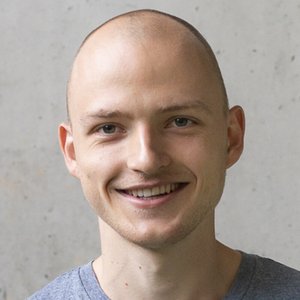
Accelerating two-photon polymerization via single-photon absorption assistance
Buse Ünlü summarizes her photopolymerization project as follows: «I introduced a method we proposed for photopolymerization, a light-based additive manufacturing technique that enables the rapid and cost-effective fabrication of complex 3D structures. Our approach combines two-photon polymerization with one-photon absorption, to get advantages of the dual capabilities, allowing for faster printing while preserving high resolution and enhancing depth sectioning.»
Malte Beccard managed to convince the audience in his lecture that silicones are fantastic materials: «It only takes a few chemical modifications, and the addition of very small amounts of salt allows one to manipulate the material's properties easily. Additionally, the dielectric properties can be switched by in-situ application of light that triggers a photoswitch of a light-responsive moiety that was attached to the polysiloxane backbone. The materials can also be easily recycled because the aforementioned photoswitch acts as a physical cross-link, which, unlike conventional chemical cross-links, allows us to reprocess our material.»
Samuele Dell'Oca talk 'Harmonizing Human-Robot Collaboration' was about a novel approach to improving collaborative robotics in manufacturing: «The focus is on enabling collaborative robots to understand and anticipate human intentions using Computer Vision and Deep Learning, allowing them to adapt their actions to enhance task performance and operator satisfaction in shared tasks.»

Harmonizing Human-Robot Collaboration
Samuele: «This recognition highlights the importance of creating more intuitive and efficient interactions between humans and robots within collaborative scenarios. SAMCE offers a valuable occasion for sharing ideas that drive innovation in advanced manufacturing, reaching out to young researchers working in similar fields and making connections for future partnerships. Receiving this award motivates me to further develop solutions that benefit both workers and industry.»
Buse: «This award and SAMCE as a whole mean a lot to me. Winning the Best IGNITE Talk Award was a great honour, further enriched by the genuine interest from the audience. It reinforced the importance of my work and motivated me to continue pushing forward, with a sense of being truly connected to the AM community. SAMCE provided an invaluable opportunity to share ideas, learn from peers, and build meaningful connections and potential collaborations, which I deeply appreciate.»
Malte: «The SAMCE award is a recognition of my work and an excellent motivator to keep up with my research. It was great to get feedback from various scientists and to learn about their interest in our materials. The event also fostered the exchange with scientists of different backgrounds. Above all, I learned that the synthesis and characterisation of materials is just the beginning of the story. The way our materials are processed has a huge impact on the final product and may also impact the environment.»

Spiropyran-functionalized Polysiloxanes: Reprocessable Elastomers with Tunable Properties via ZnCl₂
Malte: «I want to learn more about how to increase the functionality of silicones and to bring new materials closer to application. It would be amazing if we could combine the properties of the small molecules with those of the polymer to create new materials with outstanding properties. Research is all about sharing knowledge and communicating. This starts with us in our research group and extends to exchanges with researchers around the world, for example, at conferences such as SAMCE. I hope that we can develop smarter materials that are environmentally friendly and recyclable, enabling more sustainable manufacturing.»
Samuele: «My goal is to enhance this collaborative method, making cobots even more capable of understanding and adapting to human behaviour and needs in complex, real-world industrial settings. This work has the potential to significantly boost worker well-being and productivity, creating a seamless and mutually beneficial collaboration between humans and cobots. To further advance this approach, I am preparing a proposal for a young researchers’ financing framework.»
Buse: «I plan to focus more on biomedical applications that have a direct impact on people’s health. My research could benefit society by enabling the production of customized medical implants with fine-tuned geometries that fit individual anatomical needs, highly precise drug delivery devices, advanced biosensors, and other precision-engineered healthcare products that improve quality of life.»